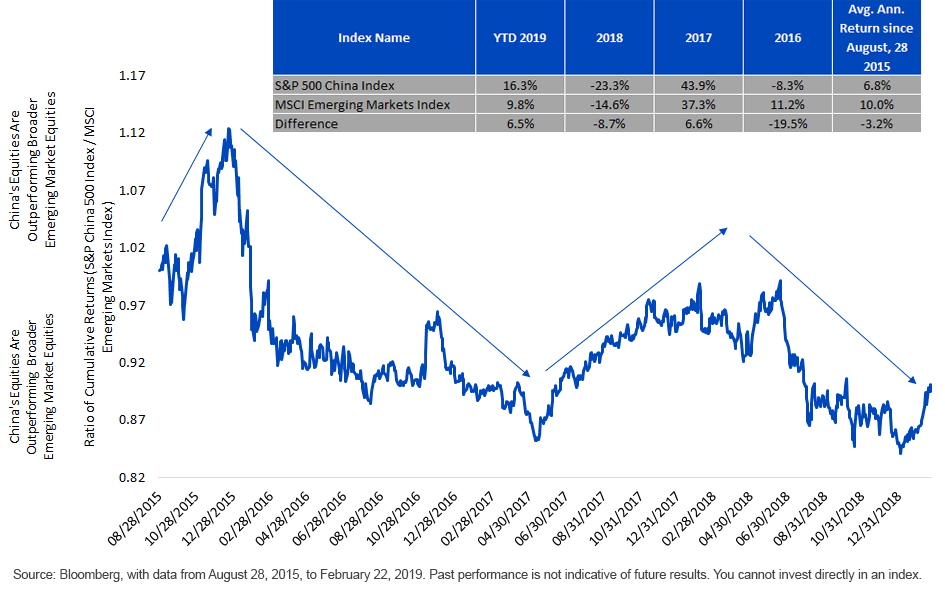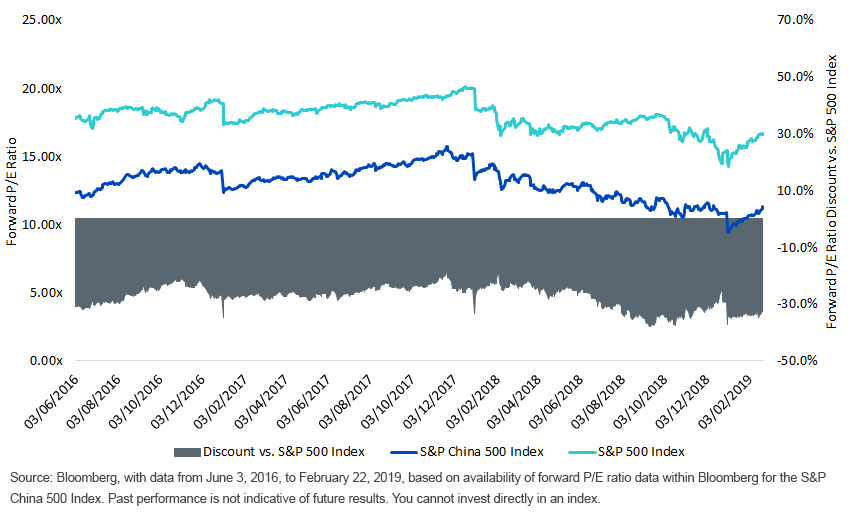Is It Time to Get Excited about Chinese Equities?


Is progress actually being made toward the ever-elusive “trade deal” between China and the U.S.?
Thus far in 2019:
- China’s equity market has been one of the best performers globally after a tough 2018. Part of this may be a recovery rally; part of it may be the recognition of various stimulative measures within China—plus the possibility of a trade deal.
- Beyond China, global equity markets have generally been rallying, as have global bond markets (whose yields have fallen) and the price of gold. A perception of high political risk and a global economic slowdown have been juxtaposed with a strong asset price rally.
Emerging Markets Charging Forward as the U.S. Federal Reserve Pauses for Now
One of the more remarkable transitions we’ve seen globally is how, in 2018, the Federal Reserve (Fed) was expected to hike policy rates four times, followed by three more increases in 2019. Merely 12 months later, we find ourselves wondering if they will hike policy rates at all this year.
When shifts like this occur, opportunities can present themselves within emerging market equities, because the U.S. dollar can move from being a headwind to a tailwind for unhedged returns.1
- In 2018, the dollar’s appreciation took away 4.50% from unhedged emerging market equity investors.
- Thus far in 2019, the dollar’s depreciation added nearly 0.75% to unhedged emerging market equity investors.
This can be additive if markets also have a catalyst to change their view on a major market like China and shifts from a bearish to a bullish sentiment can occur.
China Is a Market That Moves in Sweeping Trends
One of the primary questions many investors face is whether to take exposure to a broad benchmark or whether a more country-specific basis makes more sense.
Figure 1 indicates the performance of the S&P China 500 Index, one of the broadest equity benchmarks for China, against the MSCI Emerging Markets Index.
- It’s easy to remember the start of 2016, when China was destined for the so-called “hard landing.” This was the catalyst for a trend of China equity underperformance until the end of the first quarter of 2017.
- From about the end of April 2017 to May 2018, there was a strong year of outperformance of China’s equities over broader emerging markets. During this period, we started hearing about the “China-FAANG” stocks as the Information Technology sector was strong, similar to what was seen in the U.S.
- Emblematic of the trade tensions in place through the second half of 2018, China’s equities began to underperform broader emerging markets. This was a tough period for emerging markets overall, featuring tightening monetary policy from the Fed and a strengthening U.S. dollar. Notably, China is also the world’s second largest economy, so it is difficult to see much in the way of performance from emerging markets without China following suit.
- Similar to how the appreciation of the British pound may be implying the possibility of an eleventh-hour BREXIT deal coming together, China’s equity market seems to be front-running the possibility of a trade deal with the U.S. We’ve seen outperformance of China’s equities to start the year.
Figure 1: The Sweeping Trends of China’s Equities vs. Broader Emerging Markets

It may be tempting to think about individual sectors within China to increase the octane and cyclical nature of any strategy. Figure 2 indicates just how challenging that might be. In 2017, for example, the spread between the best and the worst of the GICS sectors was around 100%. To mitigate the risk, we think broad exposure to China’s equity market, as opposed to betting on certain sectors, will benefit any asset allocation looking to invest in China.
Figure 2: Gauging the Massive Shifts in China’s Sector Performance

Does China’s Valuation Indicate Strong Return Potential?
China, like any emerging market country, is never without significant risks. For example, it is easy to tweet about possible trade deals in order to grab headlines, but to actually negotiate bilateral trade agreements all the way to completion is notoriously difficult.
Fortunately, China’s equity market is currently trading near the steepest discount on a forward P/E ratio basis that we have seen since June 2016. A lower forward P/E ratio on its own could mean very little, but seeing a lower valuation at a time when one is getting ready to possibly capitalize on an improvement in relations between China and the U.S. could make such a strategy more interesting.
Figure 3: China’s Equities Trade at a Steep Discount to U.S. Equities

Conclusion: China May Go Down, but It’s Never Out
It is easy to get wrapped up in the short-term thought processes and headlines that always surround China. The fact is, this is the world’s second largest economy. It is a massive market that, even if growth is slowing, is still far outpacing what’s seen in developed markets. There can always be downdrafts, but in our view it’s important to look forward, as the next rally can also be right around the corner.
1Source: Bloomberg, with data for 2018 from 12/31/17 to 12/31/18 and for 2019 YTD from 12/31/18 to 2/22/19.
Important Risks Related to this Article
The Global Industry Classification Standard (“GICS”) was developed by and is the exclusive property and a service mark of MSCI Inc. (“MSCI”) and Standard & Poor’s (“S&P”), a division of The McGraw-Hill Companies, Inc., and is licensed for use by WisdomTree Investments, Inc. Neither MSCI, S&P nor any other party involved in making or compiling the GICS or any GICS classifications makes any express or implied warranties or representations with respect to such standard or classification (or the results to be obtained by the use thereof), and all such parties hereby expressly disclaim all warranties of originality, accuracy, completeness, merchantability and fitness for a particular purpose with respect to any such standard or classification. Without limiting any of the foregoing, in no event shall MSCI, S&P, any of their affiliates or any third party involved in making or compiling the GICS or any GICS classifications have any liability for any direct, indirect, special, punitive, consequential or any other damages (including lost profits), even if notified of the possibility of such damages
Christopher Gannatti began at WisdomTree as a Research Analyst in December 2010, working directly with Jeremy Schwartz, CFA®, Director of Research. In January of 2014, he was promoted to Associate Director of Research where he was responsible to lead different groups of analysts and strategists within the broader Research team at WisdomTree. In February of 2018, Christopher was promoted to Head of Research, Europe, where he was based out of WisdomTree’s London office and was responsible for the full WisdomTree research effort within the European market, as well as supporting the UCITs platform globally. In November 2021, Christopher was promoted to Global Head of Research, now responsible for numerous communications on investment strategy globally, particularly in the thematic equity space. Christopher came to WisdomTree from Lord Abbett, where he worked for four and a half years as a Regional Consultant. He received his MBA in Quantitative Finance, Accounting, and Economics from NYU’s Stern School of Business in 2010, and he received his bachelor’s degree from Colgate University in Economics in 2006. Christopher is a holder of the Chartered Financial Analyst Designation.

